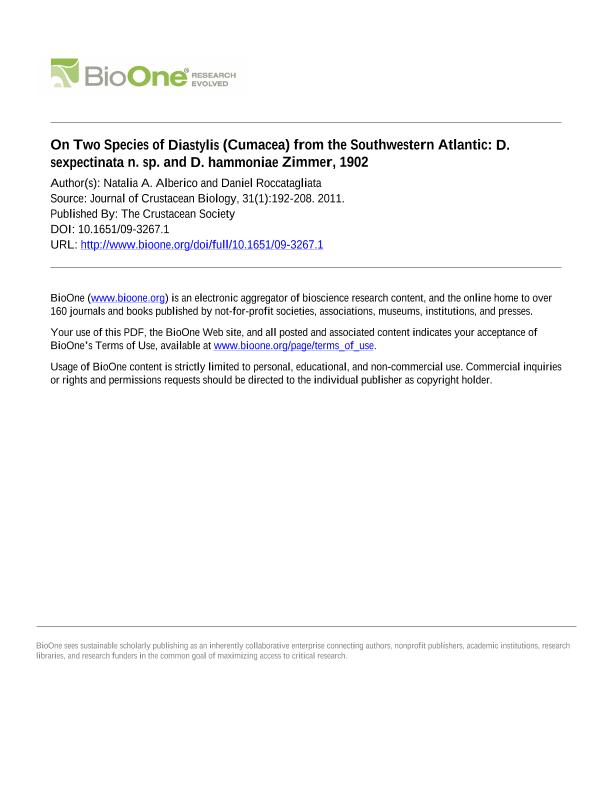Artículo
On two species of diastylis (Cumacea) from the southwestern atlantic: D. sexpectinata n. sp. and D. hammoniae zimmer, 1902
Fecha de publicación:
02/2011
Editorial:
Crustacean Society
Revista:
Journal of Crustacean Biology
ISSN:
0278-0372
Idioma:
Inglés
Tipo de recurso:
Artículo publicado
Clasificación temática:
Resumen
Diastylis sexpectinata, a new species of cumacean that extends from São Paulo State (Brazil) to northern Patagonia (Argentina), is herein fully described and illustrated. This species can be easily distinguished from the other members of the genus by the following combination of characters: 1) carapace with a pair of anterolateral horns and six longitudinal rows of conical teeth (middle and uppermost rows poorly developed or absent in the adult male), 2) third and fourth pereiopods of the female without rudimentary exopods, and 3) uropod endopod consisting of two articles, the proximal one in the female with 3-4 teeth on outer margin. The description of the female of Diastylis hammoniae is completed and the adult male described for the first time based on its type material and additional specimens herein reported. The type species of Leptostylis (?) mancoides was also re-examined and its synonymy with Diastylis hammoniae is proposed. The synonymy of D. hammoniae with Diastylis manca is also strongly suspected, but until additional specimens become available D. manca should be treated as "species inquirenda." An identification key to the species of the genus Diastylis from Argentina and Uruguay is given.
Palabras clave:
Cumacea
,
Diastylis
,
South-West Atlantic
,
Taxonomy
Archivos asociados
Licencia
Identificadores
Colecciones
Articulos(OCA CIUDAD UNIVERSITARIA)
Articulos de OFICINA DE COORDINACION ADMINISTRATIVA CIUDAD UNIVERSITARIA
Articulos de OFICINA DE COORDINACION ADMINISTRATIVA CIUDAD UNIVERSITARIA
Citación
Alberico, Natalia Andrea; Roccatagliata, Daniel Carlos; On two species of diastylis (Cumacea) from the southwestern atlantic: D. sexpectinata n. sp. and D. hammoniae zimmer, 1902; Crustacean Society; Journal of Crustacean Biology; 31; 1; 2-2011; 192-208
Compartir
Altmétricas




